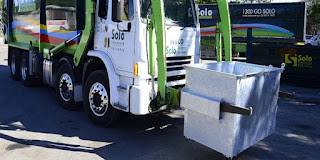Improving end-of-life usability of e-waste through recycling for a thriving circular economy in Australia
Australia
is one of the top ten electronic goods consumers in the world. Our reliance on
electronic devices is growing rapidly, making e-waste one of the country's
fastest-growing contributors to the waste stream. The volume of e-waste in
Australia is increasing due to easy access and increased usability of
electronic items, innovations in the field of communications and information
technology, lower costs of gadgets, and an increase in Australians' disposable
income.
Electronic
waste, also known as e-waste or e-scrap, is trash produced by obsolete and
discarded electronic devices. E-waste is produced by a wide range of gadgets,
electronics, and equipment that we use, including mobile phones, laptops,
motherboards, batteries, microwaves, TVs, computers, electric cookers, air
conditioners, and others. Household items, such as refrigerators and washing
machines, office devices, lighting devices, and power tools, such as power
drills, also contribute significantly to Australia's e-waste stream.
Electronics
that we use and discard contain many valuable items that are extracted from
beneath the earth using complex processes. Copper, aluminum, titanium, lead,
lithium, cobalt, iron, tin, and other metals are among them. A professional
e-waste management company can recover and reuse all of these metals in
e-waste. According to media reports, gold, silver, and bronze extracted from
discarded e-waste were used to create medals for the Tokyo Olympics.
Reusing materials from e-waste
When
your electronic device has reached the end of its useful life, recycling is the
next step in the product's lifecycle. Reusing these metals and materials from
e-waste as valuable resources in the manufacture of new products completes the
circle and results in a thriving circular economy. Adelaide Waste and Recycling
Centre offers innovative e-waste recycling solutions in Adelaide by employing
compliant practices that result in maximum e-waste reuse.
At the
company's e-waste recycling Adelaide facility, waste is shredded, sorted, and
separated using a variety of processes. Iron, for example, can be separated
using powerful overhead magnets and then processed into steel. Aluminum,
circuit boards, and copper are separated from the material stream using
mechanical processing. Water separation is commonly used to separate plastic
from glass.
Recycling e-waste
Adelaide
Waste and Recycling Centre recycles e-waste using the most up-to-date and
innovative recycling techniques to maximise e-waste reuse. Glass from
computer and television monitors, for example, can be processed for use in
concrete building products. Batteries from cell phones, laptop computers, and
other electronic devices can be processed to extract copper, aluminum, lithium,
and other precious metals for use in metal alloys or reused as raw material for
new batteries. Plastic can be recycled to make asphalt, and steel and iron from
e-waste can be used to make new steel products by e-waste recycling in
Adelaide.
Handling and treating hazardous waste
Toxic
chemicals and hazardous wastes, such as lead and mercury, may be present in
e-waste. Adelaide Waste and Recycling Centre uses advanced hazardous wastedisposal in Adelaide processes to remove hazardous waste from the e-waste
stream and treat it in a compliant manner, such as bromine, lead, zinc, and
mercury. The remaining components, such as circuit boards, cables, and metals,
can be reused by sending them to e-waste recycling Adelaide. Adelaide Waste and
Recycling Centre employs specialized processes for hazardous waste
disposal in Adelaide that ensure compliance. The company employs well-trained
personnel who are equipped to handle hazardous waste disposal in Adelaide in
accordance with EPA guidelines, ensuring that there is no negative
environmental impact.
Using specialist recyclers
Adelaide
Waste and Recycling Centre uses specialist recyclers to recover cadmium,
nickel, nickel, lithium, steel, cobalt, and other materials for use in new
batteries. In safe conditions, high-grade metals such as gold, silver, copper,
and palladium can be separated from e-waste for resale.
By
utilizing advanced e-waste recycling in Adelaide, the company ensures that the
amount of e-waste going to landfills and other waste streams is reduced,
thereby improving end-of-life e-waste handling, which is essential for building
a circular economy. As a result, Adelaide Waste and Recycling Centre is able to
conserve resources and reduce the need for raw material extraction, while
recycled e-waste is fed back into the supply chain for new products.
More waste management solutions for you
Apart from hazardous waste disposal in Adelaide and e-waste recycling in Adelaide, the Adelaide Waste and Recycling Centre offers a wide range of waste management services in Adelaide and its surrounding areas. These include tire disposal, green waste, industrial bin services, cardboard recycling, general waste, construction and demolition waste, Adelaide rubbish tip, and more. As part of its ongoing commitment to providing sustainable waste management solutions to Adelaide and surrounding communities, the company's e-waste recycling Adelaide facility is designed to ensure maximum waste separation, including hazardous waste disposal in Adelaide.



.jpg)
Comments
Post a Comment